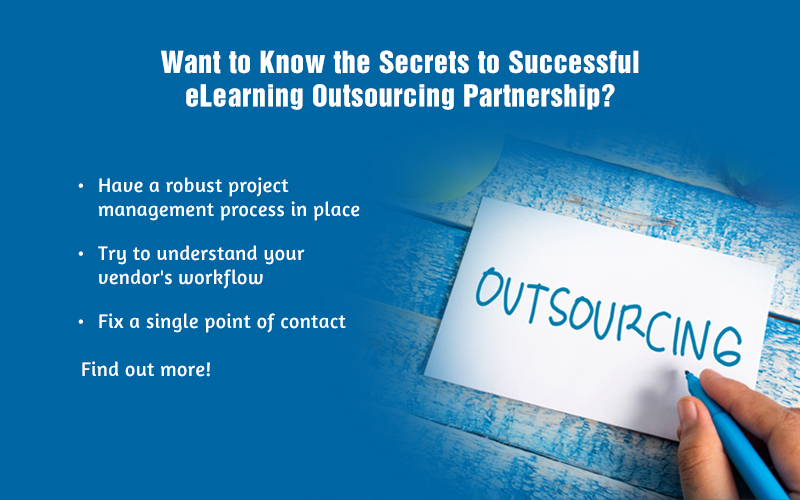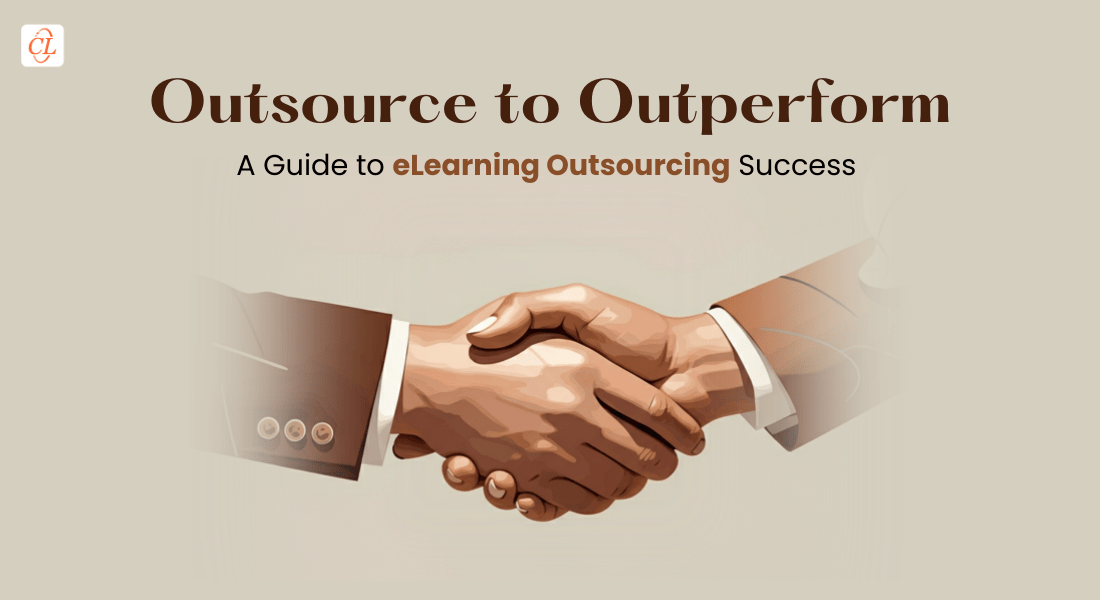The Secret to E-learning Outsourcing Success – Work with Your Partner!

Outsourcing of eLearning has stepped in to meet the evolving needs of the corporate world and is revolutionizing the way business is done in just about all sectors.
According to a report by Training Industry, the average budgets for training development outsourcing increased from $422,321 in 2017 to $219,265 in 2018.
In the light of these eye-opening statistics, it is safe to say that moving forward, the quantum of outsourcing is only going to increase, making lives easier for corporate training managers.
Having said that, successful eLearning outsourcing is not simply about delegating the development process to an external team. In this blog, I’ll discuss five ways you can support your eLearning outsourcing partner and ensure a smooth and successful outsourcing process.
How to Support Your E-learning Outsourcing Partner?
- Establish Robust Project Management Plans
- Seek to Understand Your Vendor’s Workflow, Too
- Finalize a Single Point of Contact
- Ensure Regular and Frequent Communication with the Vendor
- Have Closure Meetings After Sign-off for Long-term Collaboration
How Can You Support Your E-learning Outsourcing Partner?
1. Establish Robust Project Management
Like any other project, the success of an eLearning outsourcing project too largely depends on the project management. To ease communication between the vendor and your point/s of contact (more on this later in the blog), and to make sure the project is implemented as per requirements, a robust project management plan must be put in place—a project plan with a clear beginning, middle, and end.
By all accounts, reaping the benefits of eLearning outsourcing requires establishing essential communication channels and at the same time, the collaboration frameworks necessary to lead the development process, allowing you as an organization to focus on your business goals.
A strategic project plan includes, but is not limited to:
- Defining the project scope
- Estimating project tasks
- Determining resources needed
- Deciding on a timeline (which includes establishing a release schedule)
- Processes for review and quality assurance
- Risk assessment
- Procedures for removing development bottlenecks
You also need to discuss remedial actions that need to be taken in case the project deviates from the plan, such as reviewing the plan for release, reducing enhancements, or reallocating resources.
It goes without saying that the project plan must be approved by all the stakeholders involved in the eLearning outsourcing project—project managers, development teams, subject matter experts (SMEs)—so that the project runs smoothly.
Download our eBook on how to manage your SME’s time during the outsourcing process.
2. Seek to Understand Your Vendor’s Workflow Too
By definition, eLearning outsourcing is the use of external resources to perform activities that are traditionally carried out by in-house development teams. When an external team is involved in your training development process, they bring in their own processes and workflows, which may be quite different from your internal workflows. (This is especially true of outsourcing eLearning development to vendors from countries such as India, China, and the Philippines.)
This can get a bit overwhelming and may lead to conflicts and disagreements; but patience is the key.
Successful outsourcing projects are as much about relationships as they are about business requirements.
Nicholas C. Burkholder, in Outsourcing: The Definitive View, Applications and Implications, notes that “buyers too often regard outsourcing as simply a contract rather than a mutually beneficial relationship. Changing this mind-set involves, among other things, developing a level of trust between the vendor and purchaser.”
He also points out that “quite often neither partner [neither the client nor the vendor] behaves consistently when it comes to managing the activities in the relationship. Both sides must be able to anticipate the behavior of the other in most situations, so it needs to be made predictable.” “This, again,” he points out, “goes back to trust.” All this is to say that there really is a lot of value in trusting and understanding your vendor and their internal workflow.
3. Finalize a Single Point of Contact
A ‘single point of contact’ essentially means that all stakeholders, no matter where they are located, communicate with one dedicated person regarding the project. This helps consolidate all their inputs and feedback and sort out inconsistencies before it is forwarded to the vendor, thereby increasing both clarity and transparency.
These are the stakeholders that (ought to) remain involved throughout the eLearning outsourcing process:
- IT administrators who provide clarity on whether the available technical infrastructure can handle the classroom-to-custom eLearning transformation.
- Project managers who are often the first points of contact for the outsourcing vendor, managing the overall outsourcing process.
- SMEs who are responsible for ensuring accuracy and quality of the content being developed. They also help define the learning objectives, validate the content and provide valuable feedback.
Note: Though SME involvement is critical in the eLearning development process for their expert knowledge on the subject, it needs to be understood that SMEs are busy individuals and therefore may not have much time to be involved all through the process. So, it is recommended to get them involved right at the start as this minimizes their involvement later on.
4. Ensure Regular and Frequent Communication with the Vendor
The mantra for any eLearning outsourcing project is “communication, communication, and communication”. “Contractors… like any other business, manage their own internal processes, but they can’t manage your business,” writes startup consultant Martin Zwilling. “Don’t over-manage [them], but don’t expect them to manage your business.”
In other words, don’t expect your vendor to be your manager as well; doing so will only result in delays and low-quality output at the end of the project.
Outsourcing eLearning is not a ‘done and dusted’ deal. You will still need a dedicated team or at least a single point of contact to stay in touch with the vendors. It is important to have regular communications with the vendor for progress status reports and to respond to any queries the vendor may have. A well established and well-maintained channel of communication will result in fewer misunderstandings and helps both sides proactively address issues before they become problems.
5. Have Closure Meetings After Sign-off for Long-term Collaboration
We’ve already determined that an eLearning outsourcing project plan needs to have a clear beginning, middle, and end. In this regard, it’s important to set up a formal project closure meeting to make sure all the initially-established criteria for outsourcing are met.
Having closure meetings—instead of giving paper-based feedback—at the end of the project establishes good relationships with the vendor, not just for the ongoing project but for the future ones. Use this opportunity to get as well as give feedback from/to the vendor.
At the end of the meeting, a final close-out report should capture what went right, what went wrong, what could have been better, what were the challenges, recommended future actions, and any other information you think would be helpful in improving the efficiency of future eLearning outsourcing projects.
Concluding Remarks
Some of the most important relationships you’ll develop in your business are those with your third party vendors and suppliers. As a global corporate organization wanting to offer the best training to your employees, you will at times need to rely on external experts for their knowledge.
Outsourcing eLearning development can relieve you of the pain of in-house development, help cut costs and time to market, and leverage expertise that is not available in-house.
Go for our handy eGuide to learn more about eLearning development outsourcing, including common mistakes to avoid, and what to expect from the vendor.




![Pre-Work to Save Time when Outsourcing eLearning [Infographic]](https://blog.commlabindia.com/hubfs/Imported_Blog_Media/elearning-outsourcing-pre-work.jpg)
